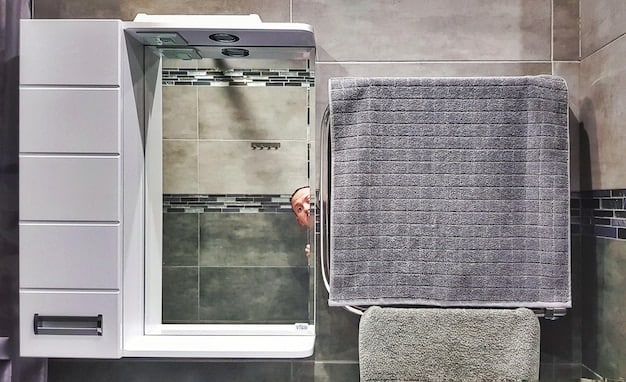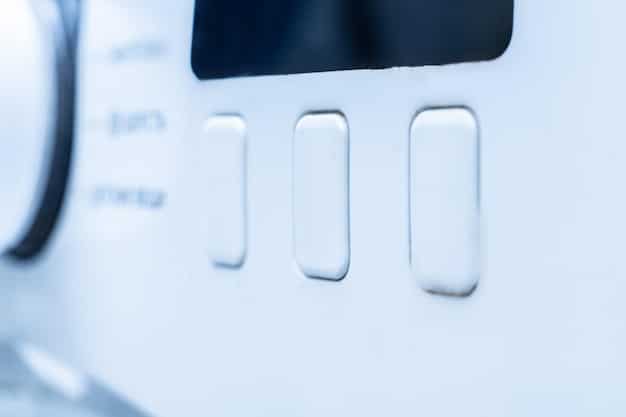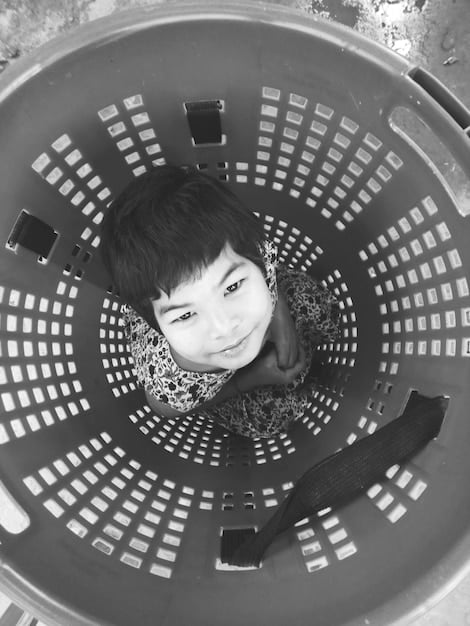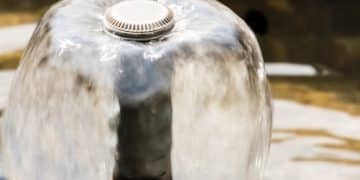Energy-Efficient Laundry: Cut Costs by 20% Now!

Your laundry room could be secretly guzzling energy and inflating your utility bills; however, making simple changes like switching to cold water washing, using energy-efficient appliances, and optimizing your laundry routine can drastically cut costs by 20% or more.
Is your laundry routine silently draining your wallet? Many homeowners don’t realize just how much energy their laundry room consumes. But the truth is, with a few strategic tweaks, you can significantly reduce your energy consumption and save money. Let’s explore how to determine if your is your laundry room an energy hog? Cut costs by 20% with these simple changes.
Understanding Laundry Room Energy Consumption
Before diving into strategies to cut costs, it’s essential to understand where your laundry room is using the most energy. Washing machines and dryers are the primary culprits, but even seemingly small things can add up over time.
The Washing Machine’s Energy Footprint
The washing machine uses energy to heat water, agitate clothes, and spin them dry. The amount of energy consumed varies based on the machine’s efficiency, the wash cycle, and the water temperature.
The Dryer’s Energy Drain
Dryers consume a substantial amount of energy to generate heat and tumble clothes. Older dryers, particularly those with electric heating elements, are notoriously inefficient. The length of drying cycles and the frequency of use significantly impact energy consumption.

Here are some critical factors that contribute to laundry room energy consumption:
- Water Temperature: Heating water accounts for a significant portion of washing machine energy use.
- Appliance Age and Efficiency: Older appliances are generally less energy-efficient than newer models.
- Frequency of Use: The more often you wash and dry clothes, the more energy you consume.
- Load Size: Running multiple small loads instead of fewer large ones wastes energy.
By understanding these factors, you can start identifying areas where you can make changes to reduce your energy consumption and lower your utility bills.
Switching to Cold Water Washing
One of the easiest and most effective ways to cut laundry costs is to switch to cold water washing. This simple change can have a significant impact on your energy consumption.
The Benefits of Cold Water
Washing clothes in cold water significantly reduces the amount of energy needed for each load. According to energy.gov, about 90% of the energy used by a washing machine is for heating water. By switching to cold water, you can save a substantial amount of energy.
When Cold Water is Sufficient
For most everyday laundry tasks, cold water is perfectly sufficient. It’s effective for cleaning lightly soiled clothes and maintaining the color and quality of fabrics. Many detergents are now formulated to work effectively in cold water, ensuring your clothes come out clean and fresh.
Here are some situations where cold water washing is ideal:
- Lightly Soiled Clothes: For items that aren’t heavily stained or dirty, cold water is often all you need.
- Bright Colors: Cold water helps prevent colors from fading and bleeding.
- Delicate Fabrics: Cold water is gentler on delicate fabrics, reducing the risk of damage.
- Everyday Items: T-shirts, jeans, and other everyday clothes can all be washed effectively in cold water.
Proper Use of Cold Water Settings
Make sure to use a detergent that’s designed for cold water washing. These detergents contain enzymes that work effectively at lower temperatures. Also, avoid overloading your washing machine, as this can reduce the effectiveness of the wash cycle. By making the switch to cold water washing, you can significantly reduce your energy consumption and save money without compromising the cleanliness of your clothes.
Investing in Energy-Efficient Appliances
Upgrading your washing machine and dryer to energy-efficient models can lead to significant long-term savings. While the initial investment may be higher, the reduced energy consumption will pay off over time.
Energy Star-Certified Washing Machines
Look for Energy Star-certified washing machines, which are designed to use less water and energy. These machines often have features like high-efficiency motors, optimized wash cycles, and advanced water-saving technology.
Heat Pump Dryers
Consider investing in a heat pump dryer, which uses a closed-loop system to recycle hot air, resulting in significantly lower energy consumption compared to traditional dryers. Heat pump dryers are more expensive upfront but can save you a lot of money on your energy bills over their lifespan.

Key features to look for in energy-efficient laundry appliances include:
- Energy Star Certification: Look for the Energy Star label to ensure the appliance meets strict energy efficiency standards.
- Water Factor: Check the water factor, which indicates how much water the machine uses per load. A lower water factor means greater efficiency.
- Modified Energy Factor (MEF): For washing machines, the MEF measures energy efficiency based on energy consumption, water consumption, and load capacity. The higher the MEF, the more efficient the machine.
- Combined Energy Factor (CEF): For dryers, the CEF measures energy efficiency based on energy consumption and load capacity. A higher CEF indicates greater efficiency.
By investing in energy-efficient appliances, you can significantly reduce your laundry room’s energy consumption and enjoy long-term savings on your utility bills.
Optimizing Your Laundry Routine
In addition to switching to cold water and using energy-efficient appliances, optimizing your laundry routine can also help you cut costs. Simple changes to how you wash and dry your clothes can make a big difference.
Run Full Loads
Avoid running small laundry loads, as they waste water and energy. Wait until you have a full load before starting the washing machine or dryer. However, be careful not to overload your machines, as this can reduce their efficiency and lead to poor cleaning or drying.
Use the Right Settings
Use the appropriate settings for each load. Avoid using high heat settings on your dryer when they’re not necessary. Air-drying clothes whenever possible can also save energy.
Regular Appliance Maintenance
Keep your washing machine and dryer clean and well-maintained. Clean the lint filter in your dryer after each load to improve airflow and reduce drying time. Periodically check and clean the hoses and connections on your washing machine to prevent leaks.
Here are some tips for optimizing your laundry routine:
- Plan Your Laundry: Schedule your laundry days to coincide with off-peak energy hours, if applicable.
- Pre-Treat Stains: Pre-treating stains can reduce the need for multiple wash cycles.
- Use Dryer Balls: Dryer balls can help separate clothes and improve airflow, reducing drying time.
By optimizing your laundry routine, you can further reduce your energy consumption and save money on your utility bills.
Implementing Smart Laundry Habits
Beyond the basics, there are several smart laundry habits you can adopt to maximize energy savings. These habits focus on reducing water usage, minimizing drying time, and making eco-friendly choices.
Reducing Water Usage
Water is a precious resource, and reducing water usage not only saves money but also helps the environment. Opt for washing machines with high water efficiency and use the appropriate water levels for each load.
Minimizing Drying Time
The dryer is one of the biggest energy consumers in the laundry room. Minimize drying time by thoroughly spinning clothes in the washing machine, using dryer balls, and air-drying clothes whenever possible.
Consider these smart laundry habits:
- Use a Drying Rack: Invest in a drying rack or clothesline to air-dry clothes, especially during warm weather.
- Check Dryer Vent: Ensure your dryer vent is clear of obstructions to improve airflow and reduce drying time.
- Eco-Friendly Detergents: Use eco-friendly detergents that are biodegradable and free of harsh chemicals.
The Impact of Eco-Friendly Choices
Eco-friendly choices can have a positive impact on the environment and your wallet. By using less water and energy, you’re reducing your carbon footprint and contributing to a more sustainable future. By implementing smart laundry habits, you can maximize your energy savings and make a positive impact on the environment.
Tracking Your Energy Savings
To see the real impact of your energy-saving efforts, it’s helpful to track your energy consumption over time. This will allow you to monitor your progress and identify any additional areas for improvement.
Monitoring Utility Bills
Compare your utility bills from before and after you implemented your energy-saving strategies. Look for reductions in your water and energy usage. Many utility companies also provide online tools that allow you to track your energy consumption and compare it to previous periods.
Using Energy Monitoring Tools
Consider using energy monitoring tools or smart home devices to track your laundry room’s energy consumption in real-time. These tools can provide valuable insights into your energy usage patterns and help you identify areas where you can make further improvements.
Here’s how to effectively track your energy savings:
- Keep a Log: Keep a log of your laundry habits, including the number of loads you wash and dry each week.
- Calculate Savings: Calculate your estimated energy savings based on the changes you’ve made.
- Adjust Strategies: Adjust your strategies as needed based on the data you collect.
By tracking your energy savings, you can see the tangible benefits of your efforts and stay motivated to continue making energy-efficient choices.
| Key Point | Brief Description |
|---|---|
| 💧 Cold Water Washing | Use cold water to reduce energy consumption. |
| ⚡ Energy-Efficient Appliances | Upgrade to Energy Star-certified machines. |
| 🧺 Optimize Laundry Routine | Run full loads and use correct settings. |
| ☀️ Air Drying Clothes | Use a drying rack to save on electricity. |
Frequently Asked Questions
▼
Most clothes can be washed in cold water, but heavily soiled items may require warm water for optimal cleaning. Check garment care labels and detergent instructions for guidance.
▼
Energy-efficient dryers, like heat pump models, can save you anywhere from $50 to $100 per year, depending on usage and local energy costs.
▼
Yes, many eco-friendly detergents are formulated to be just as effective as regular detergents, while being gentler on the environment and your clothes.
▼
You should clean your dryer’s lint filter after every load. A clean lint filter improves airflow and reduces drying time, saving energy and preventing fire hazards.
▼
Dryer balls are reusable spheres that help separate clothes in the dryer, improving airflow and reducing drying time. They can also help soften fabrics naturally.
Conclusion
By implementing these simple changes, you can transform your laundry room from an energy hog into an energy-efficient space, saving money and reducing your environmental impact. From switching to cold water washing to investing in energy-efficient appliances and optimizing your laundry routine, every little bit helps in cutting costs and contributing to a greener lifestyle.





